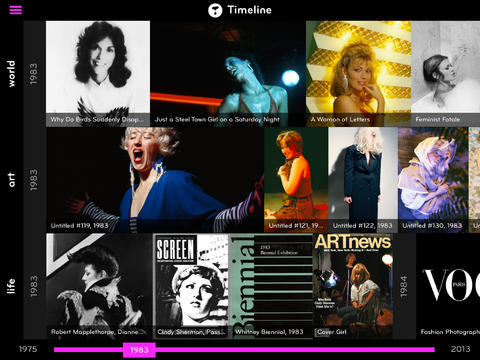Art World
The Cindy Sherman App: Not Worth 99 Cents
Art Intelligence's attempt at bringing art to the iPad is missing an ingredient.

Art Intelligence's attempt at bringing art to the iPad is missing an ingredient.

Ben Davis


iPad screenshot of the “Cindy Sherman” app, from the iTunes store
In beginning the task of reviewing the new Cindy Sherman app I guess I should say… wait, Cindy Sherman has an app? Well, why not, I suppose. I mean, a few years ago, an Atlanta steakhouse experimented with a branded app that let you flip virtual T-bones in 3-D. Now that’s art! But if artists are going to have apps dedicated to them, they better offer something really good. Unfortunately, the “Cindy Sherman” app is, as they say, pretty random.
Billed as a “mobile retrospective,” the initiative was launched last month from the company Art Intelligence with a bit of fanfare. It follows other apps from Art Intelligence about street art godfather Keith Haring and, more obscurely, Australian sculptor Patricia Piccinini. The company claims to be on a “mission to revolutionize art education” and get its products “[o]n every tablet of every teacher, student, and art geek across the globe.”
First, the good: It’s only 99 cents. And once you get past a mortifying opening essay (“She slipped on veils like Salome in reverse and spun stories like a turn of the 20th century Sheherazade”), the “Cindy Sherman” app offers, as you would hope from the name, an extensive gallery of works by the famed American artist Cindy Sherman, so it can’t be all bad. The works are organized by series, from the justly iconic “Film Stills” of 1977–80, through the gruesome “Fairytales and Disasters” of a decade later (1985–87), to her most recent series of fading society matrons. It’s a neat, orderly way to view an important artist’s creative trajectory.
But what do you get besides a picture gallery? Tap on each image and it expands to give you a larger view, plus a paragraph-length quote by some art critic, cut-and-pasted from Sherman’s press clippings. Some of these are actually about the specific image you are looking at; many are about just the series in general. Some were published at the time; some are much later commentaries on the works. The more you read these, the more haphazard they seem, as if someone ran a Bing search for, say, “Cindy Sherman Film Stills,” and took the first thing that came up. (Is a post clipped from the street art blog Wooster Collective which boldly declares Sherman’s collaboration with fashion house Balenciaga to be “spectacular” really the most acute critical take on that body of work that Art Intelligence could find? It better be, because the 300-word item is broken into chunks and serves as caption for no less than three successive images!)

iPad screenshot of the “Timeline” section of the “Cindy Sherman” app
The flashiest feature of the app is an interactive timeline. You can flip through a chronological, tiled ribbon of the same artworks from the app’s “Gallery” section, which scrolls alongside two other chronological ribbons, marked with the somewhat inscrutable labels “world” and “life.” These feature contextual information about Sherman’s influences and the historical background in general.
Now, in theory a pocket-sized way to connect an artist’s work to wider context is a good idea. But the historical connections proposed feel half-baked, like the product of a late night Cindy Sherman free-association session. Call me narrow-minded, but I’m just not convinced that Daenerys “Mother of Dragons” Targaryen from Game of Thrones really has much to do with Sherman’s late-period society portraits. (The accompanying caption, which is just a long fragment from a Salon review of Game of Thrones, doesn’t clarify any proposed connection whatsoever.)
Meanwhile, actual connections that would illuminate the work are achingly absent. Sherman’s series of “Clowns” (2003) lines up chronologically with 9/11 on the timeline, a historical event represented by an image of the burning Twin Towers titled portentously “The Day the Earth Stood Still.” But no real connection is established. Someone swiping through who didn’t know wouldn’t be able to piece together the simple fact that the “Clowns” series was actually a response to 9/11, something Sherman has spoken about quite directly (Arthur Danto even put them in an exhibition about 9/11!). This is, in other words, an art education app that doesn’t really educate.

iPad Screenshot of the “Biography” section of Art Intelligence’s “Cindy Sherman” app
What kind of experience would I want from a Cindy Sherman app? I don’t know. An app I enjoy goofing around with right now is Perfect365, which lets you apply virtual makeup to a selfie or a photo of a friend, including exaggerating features into a freakish over-worked wreck. Essentially, it’s a DIY Sherman self-portrait app. As an artist, her sensibility—all about masquerade and the uneasy line between self-fashioning and self-mutilation—is so contemporary that it is hard to see how challenging it was and is. An app that helps you see that is not a bad idea, but this is not that app. At the very least, wait for the next update before downloading.